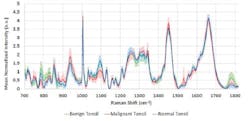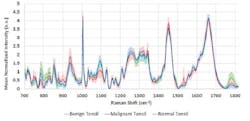Raman spectroscopy could enable earlier throat cancer detection
Oropharyngeal (throat) cancers of the tonsils and the base of the tongue related to the human papillomavirus (HPV) are frequently small, often with no early-stage symptoms, so many patients go undiagnosed until tumors have spread to lymph nodes in the neck.
Recognizing this, a team of researchers at the Vanderbilt Biophotonics Center (VBC) at Vanderbilt University (Nashville, TN) is exploring the feasibility of using Raman spectroscopy for early detection of HPV-related cancers of the throat to reduce the need for biopsies and to offer less-intensive therapies.
Raman spectroscopy uses laser light, a spectrometer, and either a microscope or a fiber-optic probe to provide information about the tissue biochemistry for evaluating the alteration of molecular signatures in a cell or tissue transformed by disease. It is used to diagnose difficult-to-locate cancers in other parts of the body, such as the cervix and gastrointestinal tract.
The research team's technique involves using a flexible fiber-optic probe to illuminate the tissue with near-infrared light and measure the Raman scattered light with the same probe. The scattered light provides a distinct biochemical profile from the tissue.
Changes in light intensity are recorded as Raman spectra by a detector and relayed to a computer system where the signal is processed and then analyzed to determine whether the tissue is cancerous or noncancerous. Using the technique, the Raman signatures are able to identify cancers without needing to take biopsies.
Representative spectra obtained using the benchmark Raman spectroscopy (Renishaw) system.
"Initial testing was performed on biopsy samples—ex vivo—with a Raman microscope. Subsequently, we used a portable clinical system with a 2.1-mm-diameter optical probe developed at the Vanderbilt Biophotonics Center that could easily fit within a laryngoscope," says Anita Mahadevan-Jansen, Orrin H. Ingram Professor of Engineering and VBC director. This technique adds only 5–7 minutes to the total time of the procedure.
The team's preliminary findings suggest that the technique has the potential to sensitively differentiate between cancer and noncancerous oropharyngeal tissues. There are no known side effects using this technique, according to the research team.
Thus far, the team has enrolled three patients undergoing surgical biopsy for diagnosis of their oropharyngeal tumors for in vivo measurements using the clinical system. Thanks to promising results, studies are currently underway in more patients to determine the effectiveness of Raman spectroscopy as a noninvasive real method for detecting oropharyngeal cancers.
The collaborative project is part of a Trans-Institutional Programs (TIPs) grant on HPV-associated cancers.

